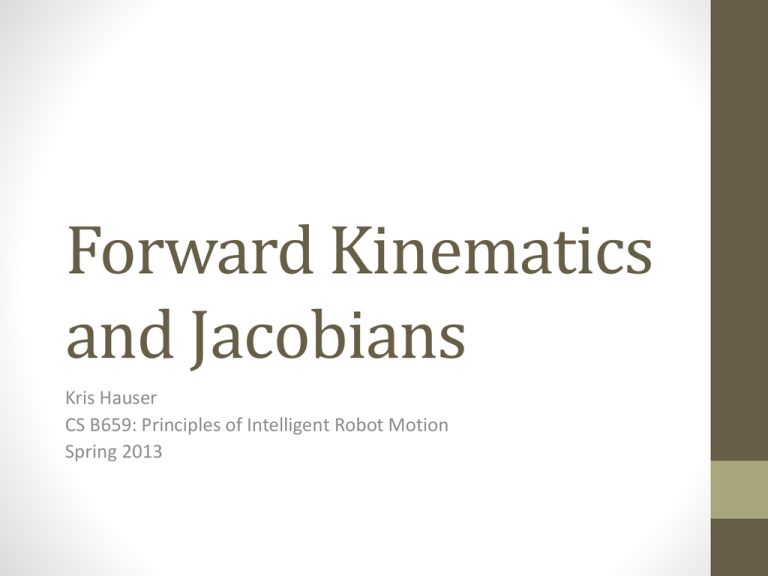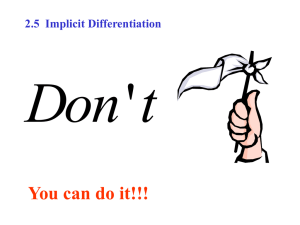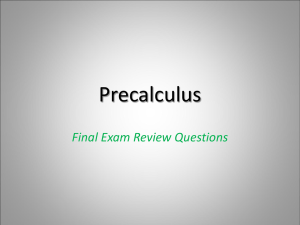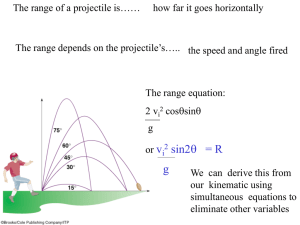Forward kinematics
advertisement

Forward Kinematics and Jacobians Kris Hauser CS B659: Principles of Intelligent Robot Motion Spring 2013 Articulated Robot • Robot: usually a rigid articulated structure • Geometric CAD models, relative to reference frames • A configuration specifies the placement of those frames (forward kinematics) q2 q1 Forward Kinematics • Given: • A kinematic reference frame of the robot • Joint angles q1,…,qn • Find rigid frames T1,…,Tn relative to T0 • A frame T=(R,t) consists of a rotation R and a translation t so that T·x = R·x + t • Make notation easy: use homogeneous coordinates • Transformation composition goes from right to left: T1·T2 indicates the transformation T2 first, then T1 Kinematic Model of Articulated Robots: Reference Frame T2ref T3ref L2 T0 T1ref L0 L1 L3 T4ref Rotating the first joint T1(q1) = T1ref·R(q1) T1(q1) T0 q1 T1ref L0 Where is the second joint? T2(q1) ? T2ref T0 q1 Where is the second joint? T2ref T0 q1 T2parent(q1) = T1(q1) ·(T1ref)-1·T2ref After rotating joint 2 q2 T2R T0 q1 T2(q1,q2) = T1(q1) ·(T1ref)-1·T2ref·R(q2) After rotating joint 2 q2 T2R T0 q1 Denote T2->1ref = (T1ref)-1·T2ref (frame relative to parent) T2(q1,q2) = T1(q1) ·T2->1ref·R(q2) General Formula Denote 𝑟𝑒𝑓 −1 𝑟𝑒𝑓 = 𝑇𝑖−1 𝑇𝑖 (ref 𝑘 𝑟𝑒𝑓 = 𝑇𝑖→𝑖−1 𝑅(𝑞𝑖 ) 𝑖=1 𝑟𝑒𝑓 𝑇𝑖→𝑖−1 𝑇𝑘 𝑞1 , … , 𝑞𝑘 T2(q1,q2) L2 T0 T1(q1) L0 L1 frame relative to parent) T3(q1,..,q3) L3 T4(q1,…,q4) Generalization to tree structures • Topological sort: p[k] = parent of link k • Denote 𝑟𝑒𝑓 𝑇𝑖→𝑝[𝑖] = 𝑟𝑒𝑓 𝑇𝑝 𝑖 −1 𝑟𝑒𝑓 𝑇𝑖 (frame i relative to parent) • Let A(i) be the list of ancestors of i (sorted from root to i) • 𝑇𝑘 𝑞1 , … , 𝑞𝑘 = 𝑟𝑒𝑓 𝑖∈𝐴(𝑘) 𝑇𝑖→𝑝[𝑖] 𝑅(𝑞𝑖 ) To 3D… • Much the same, except joint axis must be defined (relative to parent) • Angle-axis parameterization Generalizations • • • • • Prismatic joints Ball joints Prismatic joints Spirals Free-floating bases From LaValle, Planning Algorithms The Jacobian Matrix • The Jacobian of a function x = f(q), with 𝑥 ∈ 𝑅𝑚 and q ∈ 𝑅𝑛 is the m x n matrix of partial derivatives f1/q1 … f1/qn … … fm/q1 … fm/qn • Typically written J(q) • (Note the dependence on q) Aside on partial derivatives… Single Joint Robot Example (x,y) 𝑥 𝐿 cos 𝑞 𝑞 = 𝑦 𝐿 sin 𝑞 L q Single Joint Robot Example (x,y) 𝑥 𝐿 cos 𝑞 𝑞 = 𝑦 𝐿 sin 𝑞 L q 𝐽 𝑞 = 𝜕𝑥/𝜕𝑞 −𝐿 sin 𝑞 𝑞 = 𝐿 cos 𝑞 𝜕𝑦/𝜕𝑞 Single Joint Robot Example (x,y) 𝐽 𝑞 𝑥 𝐿 cos 𝑞 𝑞 = 𝑦 𝐿 sin 𝑞 L q 𝐽 𝑞 = 𝜕𝑥/𝜕𝑞 −𝐿 sin 𝑞 𝑞 = 𝐿 cos 𝑞 𝜕𝑦/𝜕𝑞 Significance • If x is an end effector, multiplying J(q) with a joint velocity vector 𝑞 gives the end effector velocity 𝑥 = 𝐽(𝑞)𝑞 𝑥 =𝐽 𝑞 𝑞 𝑦 𝐽 𝑞 (x,y) 𝐽 𝑞 𝑥 =𝐽 𝑞 𝑞 𝑦 𝑞 L 𝑞 q Computing Jacobians in general • How do we compute it? 𝑟𝑒𝑓 𝑇𝑘 𝑞 𝑥𝑘 = 𝑇𝑖→𝑝 𝑖 𝑅 𝑞𝑖 𝑥𝑘 𝑖∈𝐴 𝑘 • Consider derivative w.r.t. qj 𝜕 𝑑 𝑟𝑒𝑓 𝑇𝑘 𝑞 𝑥𝑘 = 𝑇𝑝 𝑗 𝑞 𝑇𝑗→𝑝 𝑗 𝑅 𝑞𝑗 𝑇𝑘→𝑗 𝑞 𝑥𝑘 𝜕𝑞𝑗 𝑑𝑞𝑗 Derivative… cos 𝜃 − sin 𝜃 0 • 𝑅(𝜃) = sin 𝜃 cos 𝜃 0 0 0 1 0 −1 0 −sin 𝜃 − cos 𝜃 0 𝑑 • 𝑅 𝜃 = cos 𝜃 sin 𝜃 0 = 𝑅(𝜃) 1 0 0 𝑑𝜃 0 0 0 0 0 0 0 −1 0 𝜕 𝑇 𝑞 𝑥𝑘 = 𝑇𝑗 𝑞 1 0 0 𝑇𝑘→𝑗 𝑞 𝑥𝑘 𝜕𝑞𝑗 𝑘 0 0 0 Derivative… • 𝑑 𝑅 𝑑𝜃 0 −1 0 −sin 𝜃 − cos 𝜃 0 𝜃 = cos 𝜃 sin 𝜃 0 = 𝑅(𝜃) 1 0 0 0 0 0 0 0 0 0 −1 0 𝜕 𝑇 𝑞 𝑥𝑘 = 𝑇𝑗 𝑞 1 0 0 𝑇𝑘→𝑗 𝑞 𝑥𝑘 𝜕𝑞𝑗 𝑘 0 0 0 T2(q1,q2) L2 T0 T1(q1) L1 𝜕 𝑥 𝜕𝑞𝑗 T3(q1,..,q3) L3 xk T4(q1,…,q4) Consequences… • Column j of position Jacobian Jx(q) is the speed at which x would change if joint j rotated alone • Perpendicular and equal in magnitude to vector from x to joint axis • Larger when x is farther from the joint axis T2(q1,q2) L2 T0 T1(q1) L1 T3(q1,..,q3) L3 xk T4(q1,…,q4) Orientation Jacobian • Consider end effector orientation θ(q) in plane • All entries of Jθ(q) corresponding to revolute joints are 1! • In 3D, column j is identical to the axis of rotation of joint j (in world space) at configuration q T2(q1,q2) L2 T0 T1(q1) L1 T3(q1,..,q3) L3 xk T4(q1,…,q4) Total Jacobian • Total Jacobian J(q) is the matrix formed by stacking Jx(q), Jθ(q) • 3 rows in 2D, 6 rows in 3D Next class: Inverse Kinematics • Readings on schedule: • Wang and Chen (1991) • Duindam et al (2008)











